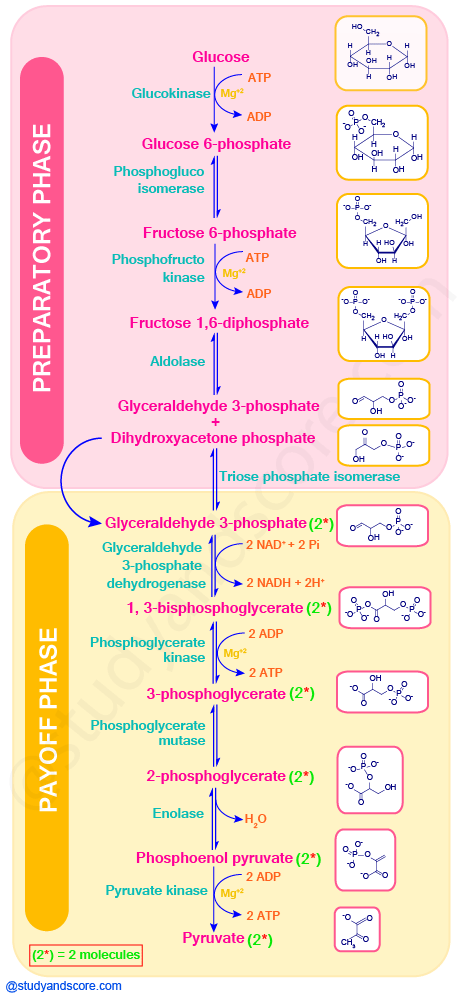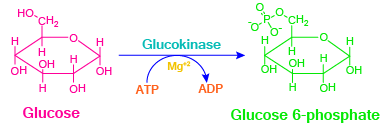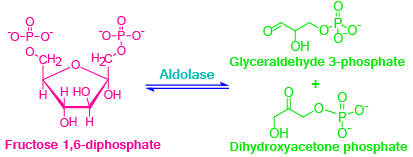Glycolysis is a greek term (glykys=sweet and lysis=splitting).
In glycolysis one molecule of glucose (6-carbon compound) is split into two molecules of pyruvate (3-carbon compound). This splitting takes place in a series of steps with release of some free energy in the form of ATP and NADH. GLycolysis was discovered by Gustav Embden, Otto Meyerhof and Karol Parnas. Hence glycolysis is also called as Embden–Meyerhof–Parnas pathway.
Glycolysis occurs in almost every cell of the body. Inside the cell, glycolysis takes place in the cytoplasm. Glycolysis is actually a sequence of ten enzyme-catalyzed reactions and these enzymes are located in the extra mitochondrial soluble fraction of the cell. Glycolysis is independent of the presence of oxygen, so it can occur both in aerobic and anaerobic ocnditions.
The following is the over all reaction of the glycolysis,
|
C6H12O6 + 2NAD+ + 2ADP + 2P ↓ 2(CH3(C=O)COOH) + 2ATP + 2NADH + 2H+ |
|---|
This process of glycolysis proceeds in two phases namely,

PREPARATORY PHASE OF GLYCOLYSIS
Step 1: Glucose to Glucose 6-Phosphate
After the transport of glucose to the cells, it is phosphorylated to form glucose 6-phosphate. This phosphorylation is catalysed by the enzyme glucokinase. It is important to note that this reaction is irreversible. Glucokinase is also called as hexokinase.

Details: This is a phosphorylation reaction. Here, a phosphate group derived from ATP is added to the glucose ring to form glucose 6-phosphate. As a result, 1 molecule of ATP is consumed. This reaction is catalysed by the enzyme glucokinase. It is also known as hexokinase. This enzyme helps in phosphorylation of 6-membered glucose-like ring structures. Here magnesium ions (Mg+2) shield the negative charges of phosphate groups present on ATP. Finally at the end of this reaction, glucose-6-phosphate is formed. It is called so because the 6′ carbon of glucose gains the phosphate group.
Step 2: Glucose 6-phosphate is converted to fructose 6-phosphate
This step involves the rearrangement and conversion of Glucose 6-phosphate to fructose 6-phosphate. This reaction is catalysed by the enzyme phosphogluco isomerase or glucose phosphate isomerase. This reaction is reversible.

Details: This is an isomerization reaction. This reaction involves the rearrangement of the carbon-oxygen bond. During this reaction the 6-membered ring opens and then closes in such a way that the first carbon is thrown out of the ring. Finally 6-membered ring is transformed into a 5-membered ring.
Step 3: Fructose 6-phosphate is converted to fructose 1, 6 diphosphate
Fructose 6-phosphate which is formed in the previous reaction is phosphorylated at 1 position to form fructose 1, 6-diphosphate. This reaction is catalysed by the enzyme phosphofructokinase. It is important to note that this reaction is irreversible.

Details: This is also a phosphorylation reaction. Here, a phosphate group derived from ATP is added to fructose 6-phosphate to form fructose 1,6-phosphate. As a result, 1 molecule of ATP is consumed. This reaction is catalysed by the enzyme phosphofructo kinase. Even here magnesium ions (Mg+2) help to shield the negative charges of phosphate groups present on ATP. Finally at the end of this reaction, fructose 1,6-diphosphate is formed. It is called so because the 1′ carbon of fructose gains the phosphate group.
Step 4: Splitting of fructose 1, 6-diphosphate
Fructose 1, 6-diphosphate is split into two triose phosphate molecules. One is an aldotriose named glyceraldehyde-3-phosphate and other is a ketotriose named dihydroxy acetone phosphate. The reaction is reversible. In this reaction, there is neither there is expenditure of energy nor formation of ATP. This reaction is reversible.
Details: This is a cleavage reaction catalyzed by the enzyme aldolase. This reaction involves the cleavage of Fructose 1,6-biphosphate into two 3-carbon molecules namely, glyceraldehyde-3-phosphate (GAP) and dihydroxyacetone phosphate (DHAP).
Step 5: Interconversion of Triose phosphates
Both triose phosphates formed in the previous reaction can be interconverted with the help of enzyme triose phosphate isomerase. This conversion is reversible.

Details: This is an isomerization reaction. As GAP is the only molecule that continues further in the glycolytic pathway, DHAP molecules are isomerized and reorganized into GAP molecules by the enzyme triphoshpate isomerase.
PAY OFF PHASE OF GLYCOLYSIS
Step 6: Glyceraldehyde 3-phosphate is oxidised to 1,3-bisphosphoglycerate
Glycolysis proceeds by the oxidation of glyceraldehyde 3-phosphateto form 1,3-bisphosphoglycerate. The reaction is catalyzed by the enzyme glyceraldehyde 3-phosphate dehydrogenase. This reaction is reversible.

Details: The two main events occuring in this step are
1) Oxidation of glyceraldehyde-3-phosphate (GAP) by the coenzyme nicotinamide adenine dinucleotide (NAD). Here, the peculiar structure of enzyme GAPDH holds GAP in a particular conformation so as to allow NAD molecule to pull off a hydrogen from GAP. Thereby converting the NAD to NADH.
2) Phosphorylation of oxidized glyceraldehyde-3-phosphate by the addition of a free phosphate group. This reaction is catalyzed by the enzyme glyceraldehyde-3-phosphate dehydrogenase (GAPDH). The phosphate group attacks the 2 GAP molecules and releases it from the enzyme to give out 2 molecules of 1,3-bisphoglycerate, 2 NADH, and 2 hydrogen atoms.
Step 7: 1, 3-bisphosphoglycerate is converted to 3-phosphoglycerate
1, 3-bisphosphoglycerate formed in the previous reaction is converted to 3-phosphoglycerate by the transfer of phosphate bond at position-1 to ADP. This is an energy yielding reaction whereby ATP is released. The reaction is catalysed by the enzyme phosphoglycerate kinase. This reaction is reversible.

Details: This is Substrate level phosphorylation reaction. This reaction involves the removal of a phosphate group from 1,3-bisphosphoglycerate and transfer of this phosphate to a molecule of ADP. As a result the first ATP molecule is yielded. As we actually have 2 molecules of 1,3-bisphoglycerate (because there were two 3-carbon products from Phase II of glycolysis), we actually yielded two molecules of ATP at the end of this step. By the end of this step we have spent and received 2 ATP molecules. Even here magnesium ions (Mg+2) help to shield the negative charges of phosphate groups present on ATP.
Step 8: 3-phosphoglycerate is converted to 2-phosphoglycerate.
Two molecules of 3-phosphoglycerate formed by the above reaction is converted to two molecules of 2-phosphoglycerate. In this reaction, the phosphate group is recovered from 3-phosphoglycerate. This reaction is catalyzed by the enzyme phosphoglycerate mutase. This reaction is reversible.

Details: This is a rearrangement reaction where in the position of phosphate group is rearranged on the 3-phosphoglycerate molecule to make it 2-phosphoglycerate. The reaction is catalyzed by phosphoglycerate mutase (PGM). A mutase catalyzes the transfer of a functional groups from one position to other. First an additional phosphate group is added from the enzyme to 2′ position of the 3-phosphoglycerate and then phosphate at 3′ position is removed. Finally only the phosphate at 2′ position is left and thus yielding 2 phosphoglycerate. In this way, the enzyme restores its original phosphorylated state.
Step 9: 2-phosphoglycerate is converted to phosphoenol pyruvate
Two molecules of 2-phosphoglycerate formed by the above reaction is converted to two molecules of phosphoenol pyruvate. This reaction is catalysed by the enzyme enolase. Enolase requires the presence of either Mg2+ or Mn2+ ions for its activity. This reaction is reversible.

Details: This is a dehydration reaction catalysed by enzyme enolase. This enzyme removes a water group from 2-phosphoglycerate and converts it into phosphoenolpyruvate (PEP). This enzyme has great specificity and completes the reaction in a series of precise and complicated steps.
Step 10: Phosphoenol pyruvate is converted to pyruvate
Two molecules of Phosphoenol pyruvate is converted to two molecules of pyruvate in the presence of enzyme pyruvate kinase. In this reaction, high energy phosphate group of phosphoenol pyruvate is transferred to ADP and thus ATP is produced. This reaction is irreversible. This is Substrate level phosphorylation reaction.

Details: This is a substrate level phosphorylation reaction catalysed by the enzyme pyruvate kinase. This enzyme transfers a phosphate group from 2′ carbon of the Phosphoenol pyruvate (PEP) to ADP thus yielding ATP. Here as there are two molecules of PEP, we actually yield 2 ATP molecules.
During Aerobic phase of glycolysis ATP molecules are consumed and formed in the following reactions:
| Reactions catalyzed | ATP used | ATP formed |
|---|---|---|
| Glucokinase in step 1 | 1 | - |
| Phosphofructokinase in step 3 | 1 | - |
|
Glyceraldehyde 3-phosphate dehydrogenase in step 6 1 NADH= 3 ATP. Here we get 2 NADH so 6 ATP |
- | 6 |
| Phosphoglycerate kinase in step 7 | - | 2 |
| Pyruvate kinase in step 10 | - | 2 |
| Total | 2 | 10 |
Net gain = (10-2) = 8ATP
*Actual Net visible ATP produced is only 2 if we exclude NADH.
Occurrence: In the cytoplasm
Reactants: One molecule of glucose, 2 NAD+, 2ADP and 2 inorganic phosphate
Reaction:
C6H12O6 + 2NAD+ + 2ADP + 2P
↓
2(CH3(C=O)COOH) + 2ATP
Products: Two molecules of Pyruvate, 2 ATP, 2 NADH and 2 Protons
Way ahead: If the cell has enough oxygen, two pyruvate molecules will be transformed to Acetyl CoA. Acetyl CoA enters mitochondrial matrix and proceeds to Krebs cycle.
Hope you have liked this post.
Please share it with your friends through below links.
All the very best from Team Studyandscore
“Study well, Score more…”
- Share with your friends! -
Login to post your comment here...
- or with social Account -